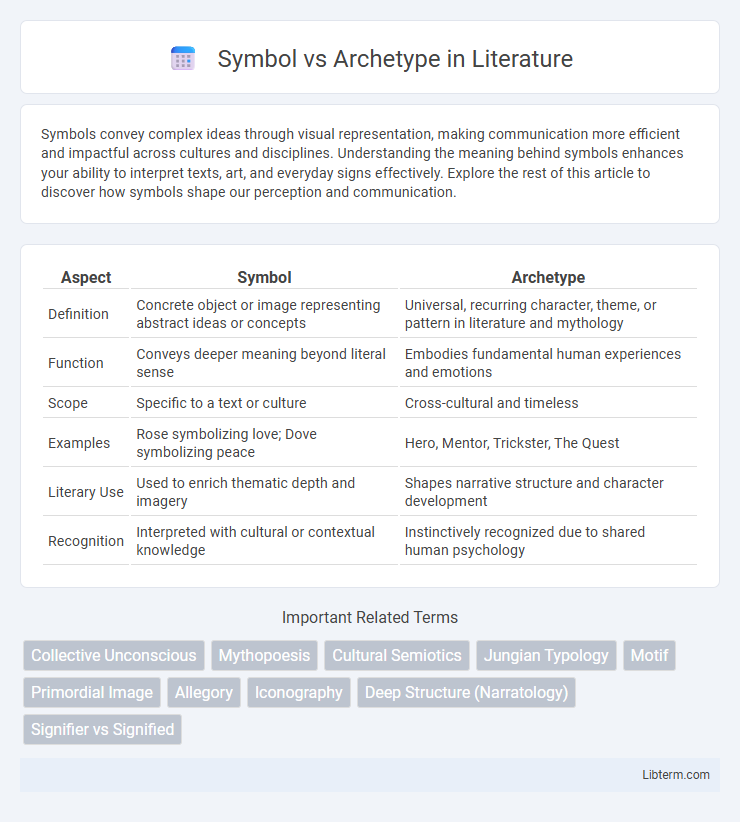Symbols convey complex ideas through visual representation, making communication more efficient and impactful across cultures and disciplines. Understanding the meaning behind symbols enhances your ability to interpret texts, art, and everyday signs effectively. Explore the rest of this article to discover how symbols shape our perception and communication.
Table of Comparison
| Aspect | Symbol | Archetype |
|---|---|---|
| Definition | Concrete object or image representing abstract ideas or concepts | Universal, recurring character, theme, or pattern in literature and mythology |
| Function | Conveys deeper meaning beyond literal sense | Embodies fundamental human experiences and emotions |
| Scope | Specific to a text or culture | Cross-cultural and timeless |
| Examples | Rose symbolizing love; Dove symbolizing peace | Hero, Mentor, Trickster, The Quest |
| Literary Use | Used to enrich thematic depth and imagery | Shapes narrative structure and character development |
| Recognition | Interpreted with cultural or contextual knowledge | Instinctively recognized due to shared human psychology |
Defining Symbols: Meaning and Usage
Symbols represent concrete images or objects that convey deeper meanings beyond their literal sense, often rooted in cultural or contextual significance. Unlike archetypes, which are universal, innate patterns found across myths and literature, symbols derive their meaning from specific societal or situational contexts. Effective use of symbols involves understanding their historical background and cultural resonance to communicate complex ideas succinctly.
What Are Archetypes? Key Characteristics
Archetypes are universal, recurring symbols or patterns that reside in the collective unconscious, shaping human experiences and storytelling across cultures. Key characteristics include their innate nature, timelessness, and ability to evoke deep, subconscious responses through familiar motifs like the hero, the mentor, or the shadow. Unlike symbols, which can be culture-specific and context-dependent, archetypes represent fundamental human truths and psychological constructs shared globally.
Historical Origins of Symbolism and Archetypes
Symbols trace back to ancient civilizations, where pictographs and ideograms conveyed complex ideas and cultural beliefs through visual representation. Archetypes originate from Jungian psychology, rooted in collective unconscious concepts that reflect universal themes and motifs shared across human history and mythology. Both symbolism and archetypes serve as tools to unlock deeper meanings, with symbols often specific to cultures and archetypes representing fundamental human experiences.
Symbols vs Archetypes: Core Differences
Symbols represent specific objects, actions, or ideas that convey particular meanings within a cultural or literary context, often fixed and context-dependent. Archetypes are universal, recurring patterns, characters, or themes that span across cultures and time, embodying fundamental human experiences. The core difference lies in symbols being concrete and variable, while archetypes function as abstract, timeless templates shaping collective unconscious narratives.
Psychological Perspectives on Symbols and Archetypes
Symbols represent specific ideas or concepts, serving as concrete representations in the unconscious mind, while archetypes are universal, primal images and patterns ingrained in the collective unconscious, shaping human experience and behavior. Psychological perspectives, especially those influenced by Carl Jung, emphasize that archetypes manifest through symbols in dreams, myths, and art, providing insight into inner conflicts and guiding personal development. Understanding the interplay between symbols and archetypes aids in deciphering unconscious motivations and fosters psychological healing and self-awareness.
Symbolism in Literature and Art
Symbols in literature and art function as tangible representations imbued with deeper meanings that evoke complex ideas or emotions beyond their literal sense. Unlike archetypes, which are universal, recurring motifs or character types rooted in collective unconscious, symbols carry culturally specific significance shaped by historical and social contexts. The use of symbolism enhances thematic depth, allowing creators to communicate layered messages and engage audiences through interpretive interaction.
Archetypes in Mythology and Storytelling
Archetypes in mythology and storytelling represent universal, recurring symbols or motifs that embody fundamental human experiences and emotions, such as the Hero, the Mentor, or the Shadow. These archetypes provide a framework for narratives, enabling audiences to connect deeply with characters and themes across cultures and time. Their semantic richness allows stories to convey complex psychological and cultural truths effectively, making archetypes essential tools in literary analysis and creative writing.
The Role of Culture in Shaping Symbols and Archetypes
Symbols and archetypes are deeply influenced by cultural contexts, as they embody the collective values, beliefs, and experiences of a society. Cultural narratives shape archetypes like the Hero or the Trickster, which resonate universally yet manifest uniquely in different cultures due to varying traditions and historical backgrounds. The interpretation of symbols often depends on culturally specific meanings, making them dynamic tools for communication that evolve alongside societal changes.
Interplay Between Symbols and Archetypes
Symbols and archetypes intertwine deeply in literature and psychology, with symbols serving as tangible representations that evoke archetypal themes rooted in the collective unconscious. The interplay between symbols and archetypes enhances narrative depth by connecting individual experiences to universal patterns, such as the hero's journey or the mother figure. This dynamic relationship allows symbols to trigger archetypal meanings, enriching interpretation through culturally and psychologically embedded motifs.
Modern Applications in Media and Branding
Symbols in modern media and branding function as recognizable icons or logos that convey specific meanings quickly, such as the Nike swoosh representing athleticism and motivation. Archetypes serve as deeper, universal characters or themes in storytelling and brand identities, like the Hero archetype embodied by characters in films or companies like Apple inspiring innovation and empowerment. Combining symbols with archetypal narratives enhances audience connection and brand loyalty by embedding familiar psychological patterns into visual and thematic elements.
Symbol Infographic

 libterm.com
libterm.com